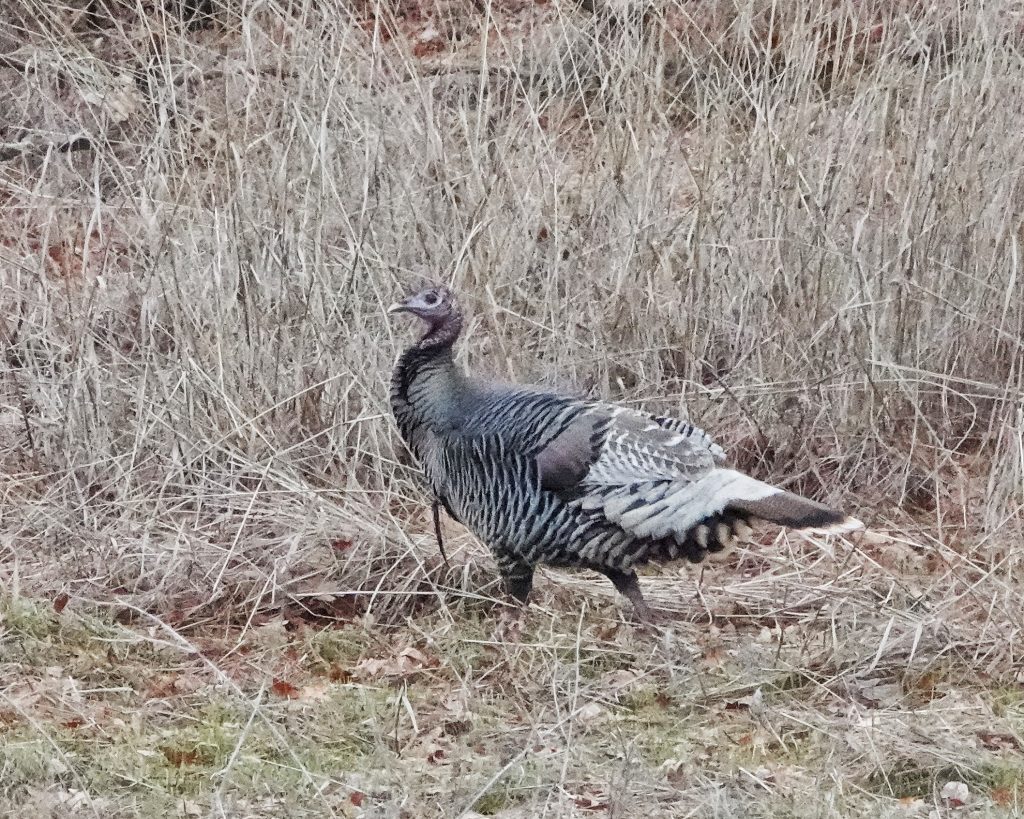
This past weekend Pam and I took our regular late winter field trip to the central Columbia River Gorge. The wide open vistas, with only scattered clumps and patches of trees, are a good antidote to the slightly claustrophobic feelings I get hemmed in by trees and low clouds during a westside winter. Plus there is always the possibility of early wildflowers at Catherine Creek, and with the trees and underbrush denuded of leaves it seems more possible to see interesting vertebrate wildlife. And we did see at least 20 blacktail deer on the trip, but the highlight was seeing well over a dozen wild turkeys along old Hwy. 8, none of which were full fledged toms, though I think there were a couple of jakes. But the flock (turkey flocks are called rafters) was only 60 yards or so from the road and a convenient pulloff, and they were unconcernedly foraging in a downslope grassy woodland, a’huntin’ and a’peckin’ their way from one thicket to another.
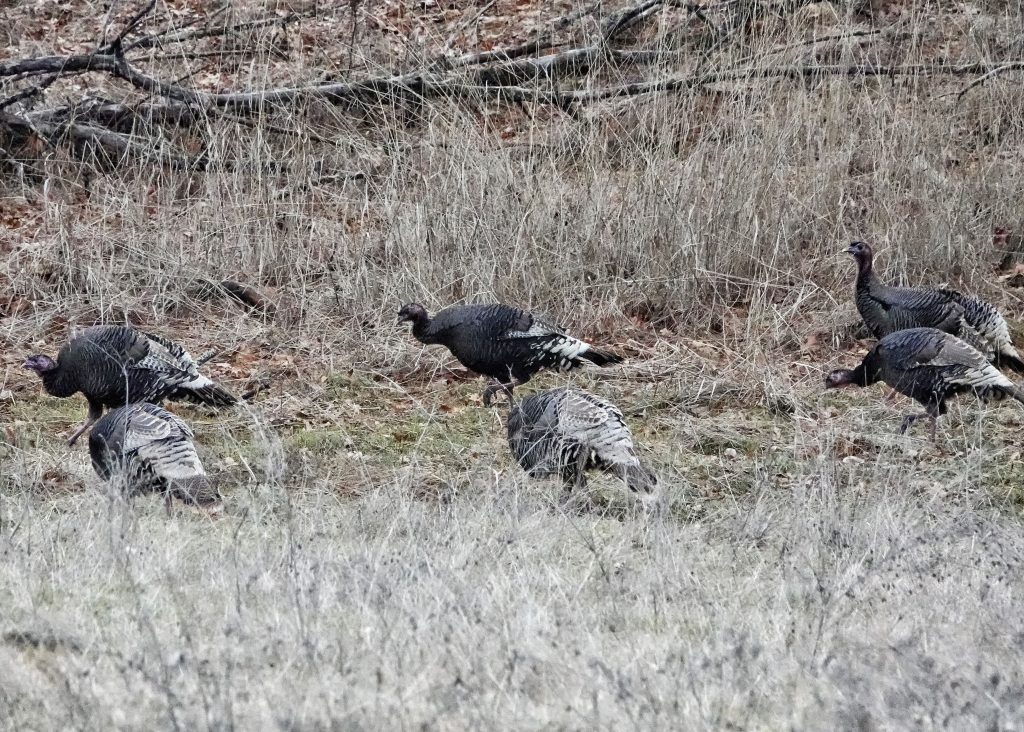
It’s not that wild turkeys are rare, though they can be wary, and are often hidden by the undergrowth. And we just don’t really spend that much time in turkey territory. But they aren’t always secretive. Outside of Kalispell, Montana I once saw at least fifty turkeys perched on one of those huge rolling irrigation systems (known as wheel lines or siderolls) right next to, and facing, the highway, looking for all the world like the loafers and gossips one sees lined up out front of a general store in old movies. I could almost hear them debating the merits of the various makes of vehicles passing them by.
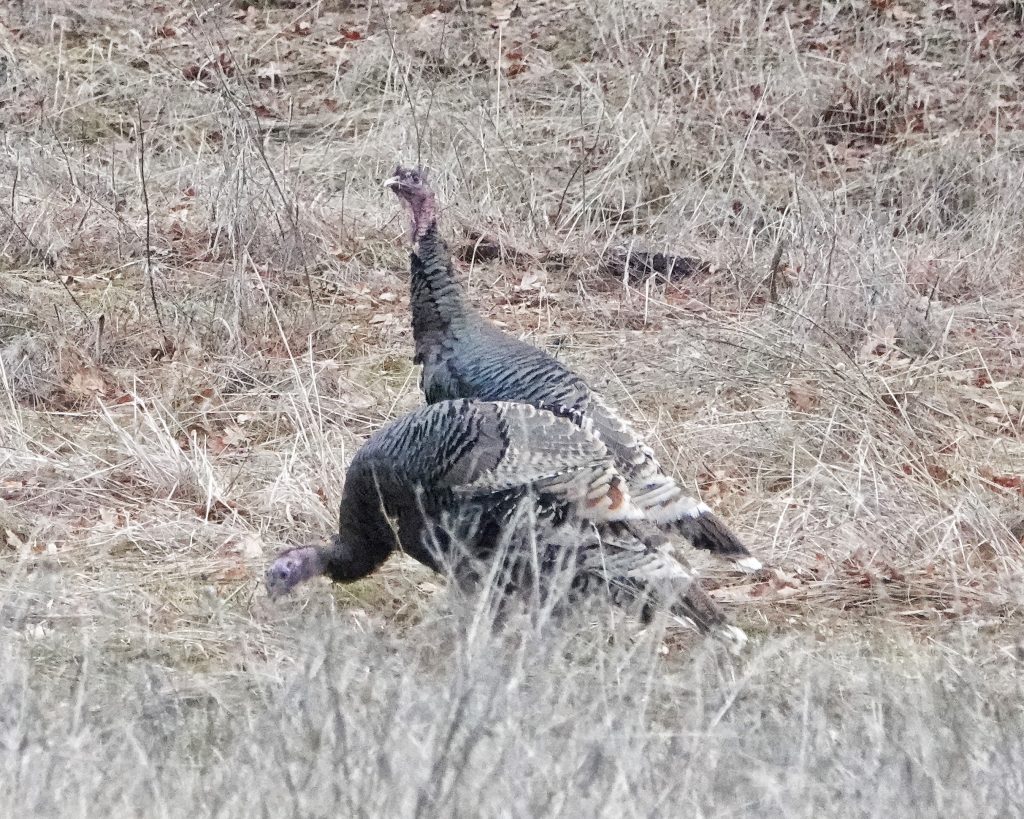
Before we go any further into facts about wild turkeys I’d like to address a myth about them as regards Benjamin Franklin. Ol’ Ben neither advocated for the wild turkey as our national symbol, nor opposed the bald eagle. What he said, in a satirical letter to his daughter, was that complaints that the bald eagle depicted on the crest of the Society of the Cincinnati looked too much like a ‘Dindon, or Turkey’ didn’t ring well with him, since the bald eagle was “…a Bird of bad moral Character”, and that he was pleased it didn’t look like a “…a Bald Eagle, but looks more like a Turkey. For in Truth the Turkey is in Comparison a much more respectable Bird, and withal a true original Native of America … He is besides, though a little vain & silly, a Bird of Courage, and would not hesitate to attack a Grenadier of the British Guards who should presume to invade his Farm Yard with a red Coat on.” But all this was penned 2 years after the bald eagle had been chosen as our National symbol.
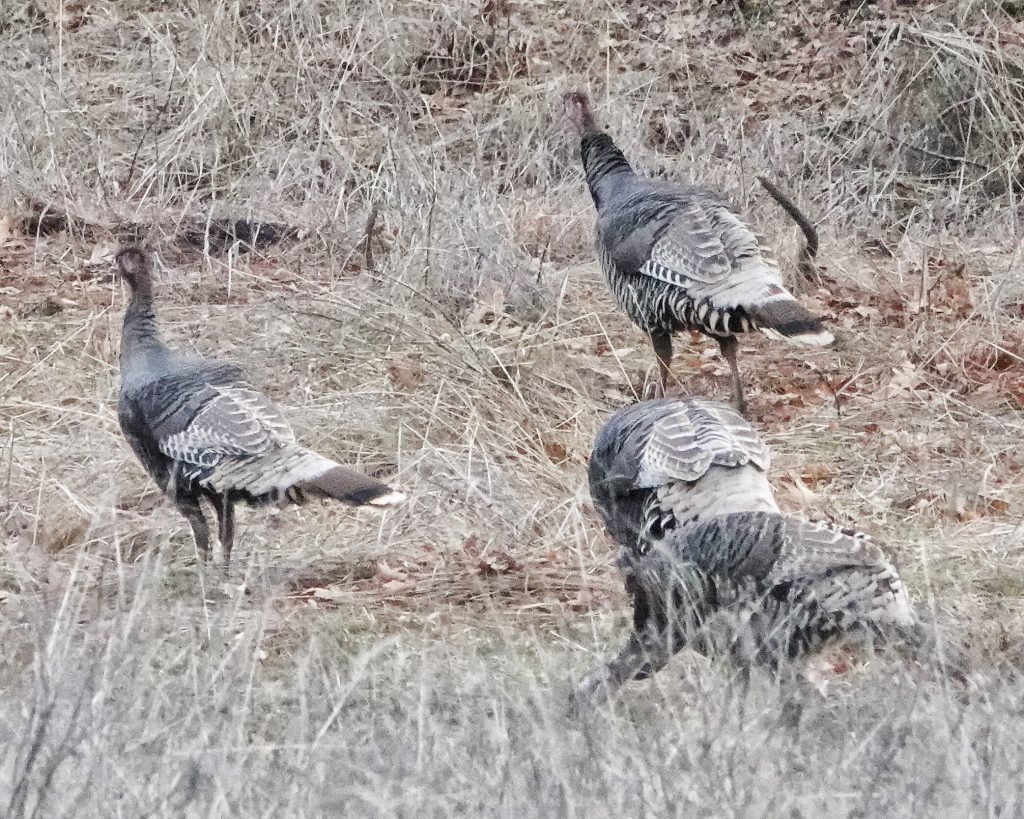
Wild turkeys are native to eastern North America, west and south through the plains states, and into the montane regions of Colorado, New Mexico, and Arizona, as well as into northern and central Mexico. These members of the family Phasianidae (which includes, amongst others, pheasants, grouse, chukars, chickens, and peafowl) are one of only two species of turkeys still living in this world, the other being the ocellated turkey (Meleagris ocellata), which is native to the Yucatán Peninsula. Over harvest and habitat loss had extirpated Meleagris gallopavo from many parts of their range by the late 1800s, and in the early 1900s, when estimates put their population at around 100,000 (down from possibly as many as 10 million) efforts began to reintroduce them. However those first attempts were done using farm raised birds and the survival rates were low, and by 1930 the population was down to around 30,000. In the 1940s a process began of transplanting wild birds from healthy populations into areas where they were lacking, and this has been very successful. Estimates now place the wild turkey population in North America at around 7 million birds.
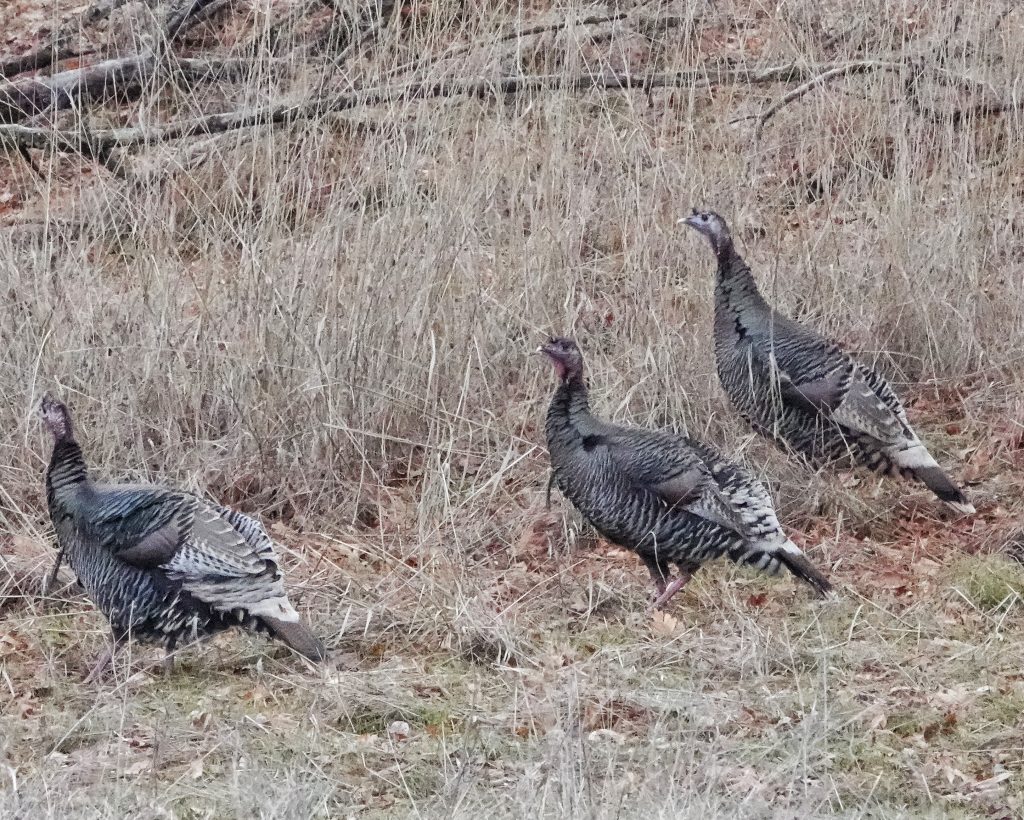
They have been widely and successfully introduced into many parts of western North America, including a variety of places in the PNW. There are 5 subspecies of Meleagris gallopavo, 3 of which have been introduced into our region; Eastern turkeys (Meleagris gallopavo silvestris) do best in moist to mesic hardwood and mixed forests, such as are found west of the Cascades; Merriam’s turkeys (M. g. merriami), like the ones we found in Klickitat County, Washington, prefer mesic to arid conifer/oak woodlands mixed with meadows and other open areas, and have been widely introduced east of the Cascades; and Rio Grande turkeys (M. g. intermedia) prefer prairies and grasslands with some wooded areas for roosting, and have been introduced into se Washington, ne Oregon, and the Willamette Valley.
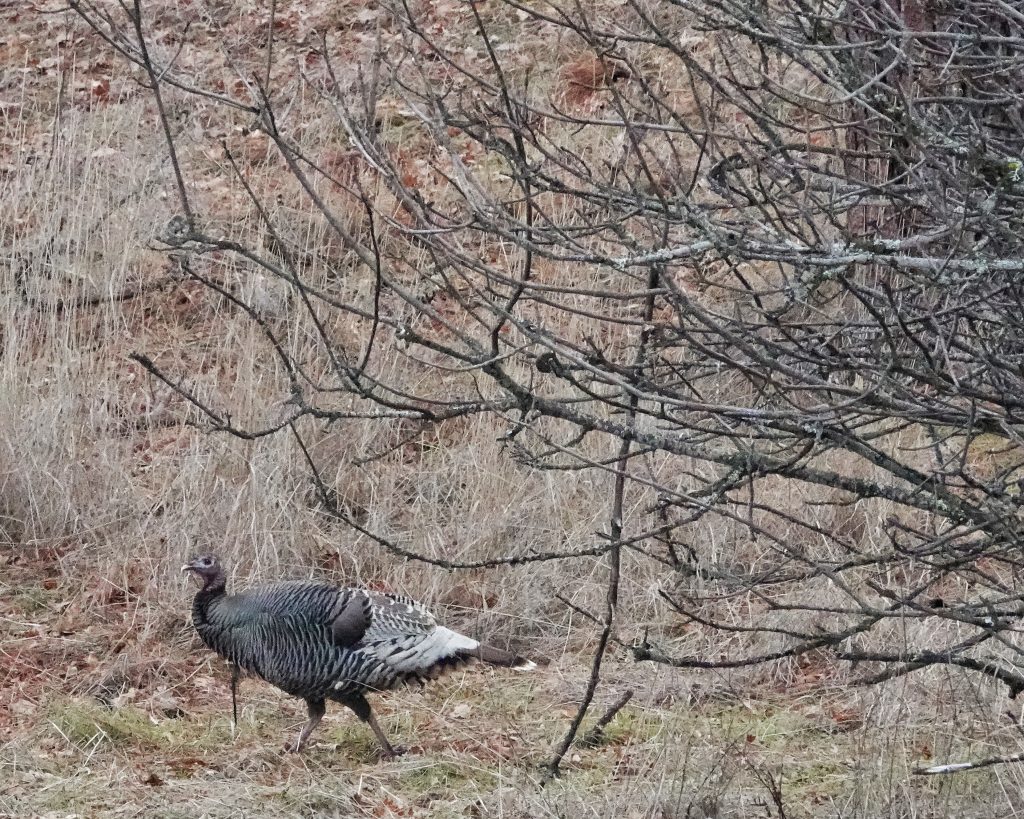
Turkeys are polygamous, and the dominant toms do the bulk of the breeding, and provide no parental care. Breeding happens in the spring, and during courtship the toms gobble both to attract hens and to warn off competing males. When interested hens are nearby the toms display by strutting with fanned tails, engorged snoods, raised feathers, and dragging wings, whilst making humming and chuffing sounds. Outside of the mating season males form their own rafters which have a constantly shifting heirarchy. Females and their immature offspring form their own rafters with other family groups, and those groups have a relatively stable hierarchy of dominant hens.
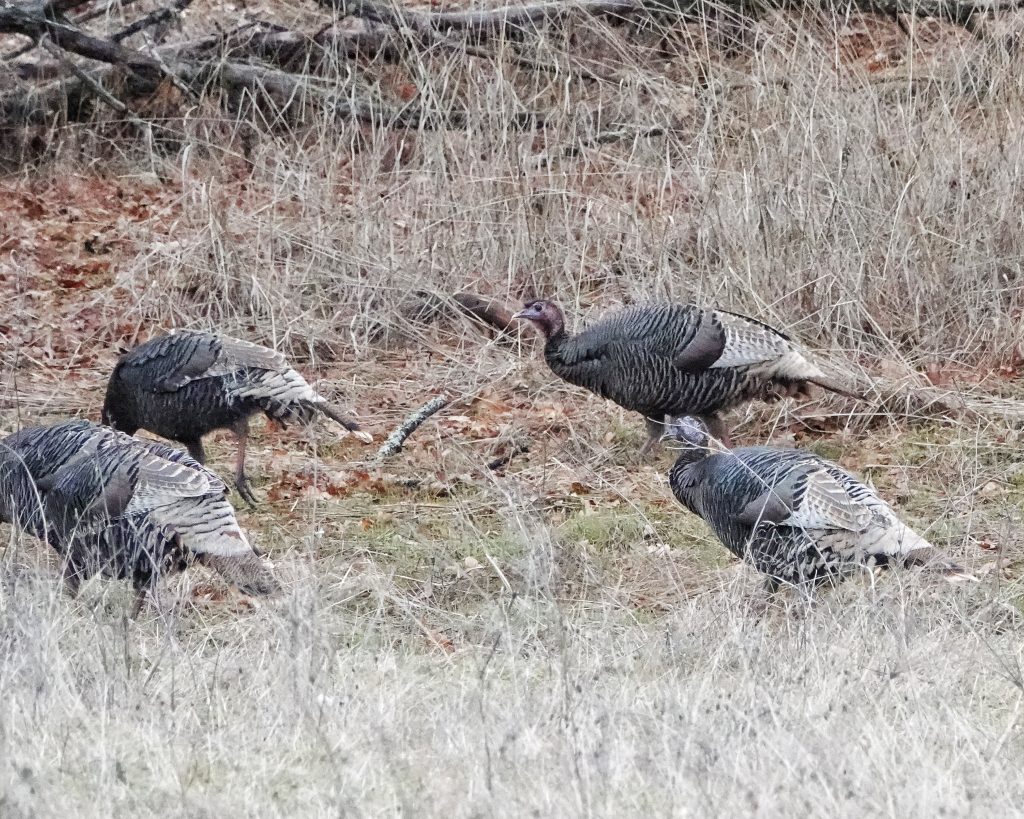
Though they spend most of their daylight hours walking on the ground, turkeys can run at speeds over 20 mph, and can fly at over 50 mph. When threatened, hens usually fly, while toms prefer to run, possibly because of their greater bulk. At sunset turkeys fly into trees to roost, working their way to the highest viable perch. They tend to roost in flocks, but will also do so individually. Turkeys have extraordinary vision, with about 3 times the acuity of the human norm, and they have color vision, along with a 270⁰ field of vision. This combination of visual abilities is why turkey hunters wear heavy camouflage and try to remain motionless.
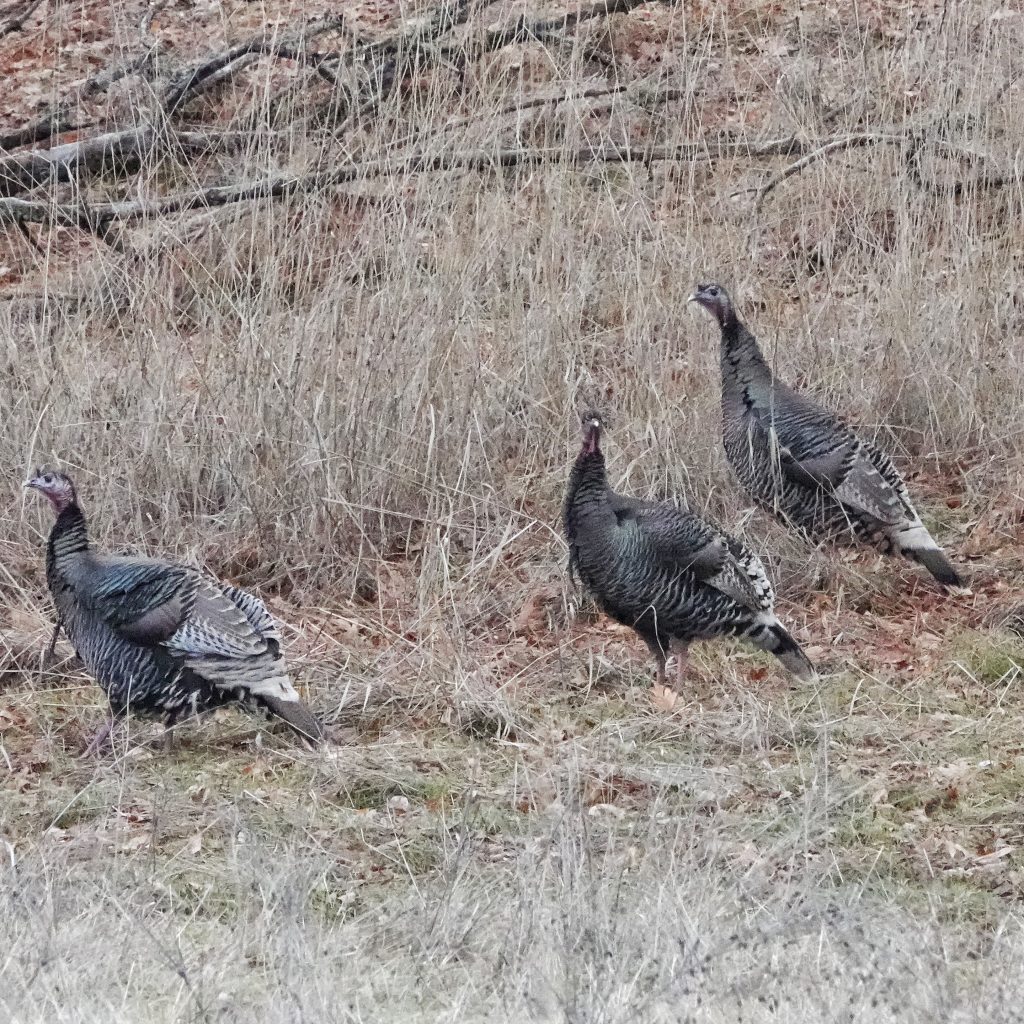
As might be expected for a large and abundant bird, wild turkeys were an important part of the diet of many indigenous peoples, who not only consumed the meat fresh but jerked it for future use, and ate the eggs as well. Some tribes even did controlled burns to maintain good turkey habitat. They are also culturally significant, with turkey feathers being used in rituals and headdresses of many tribes. One of the three clans of the Lenape was called the Turkey Clan, and important members of the Wampanoag and Muscogee tribes wore entire cloaks of turkey feathers. The Navajo consider wild turkeys to be sacred birds, and their folklore tells of Tązhii bringing corn and seeds into this world.
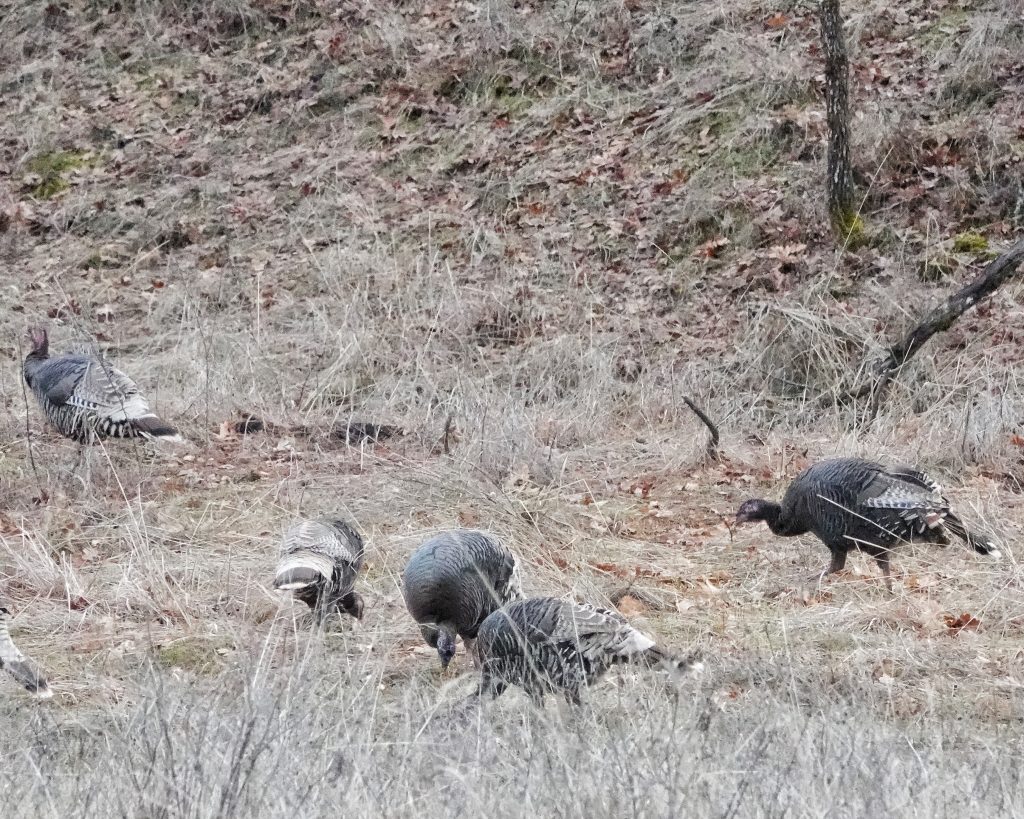
Our barnyard turkeys are descended from the South Mexican turkey (M. g. gallopavo) which appears to have been domesticated around 2000 years ago. Spanish explorers brought these tamed birds to Europe from the New World in the mid 1500s, and the Pilgrims brought them back to America in 1620, apparently unaware that there were wild populations of turkeys here already. A few more fun facts about turkeys; you can age and sex a turkey from its droppings, since larger diameter feces indicates older birds, and males have j-shaped stools, whilst those of females are spiral in shape. Our wild turkeys have been around for at least 20 million years. Finally, I would be remiss if I didn’t mention one of the most fascinating documentaries I have ever seen- “My Life as a Turkey” (2011), which details the year Joe Hutto spent with a rafter of wild turkeys that he raised from eggs and ‘mothered’ in the Florida Everglades. It will open your eyes in more ways than one.
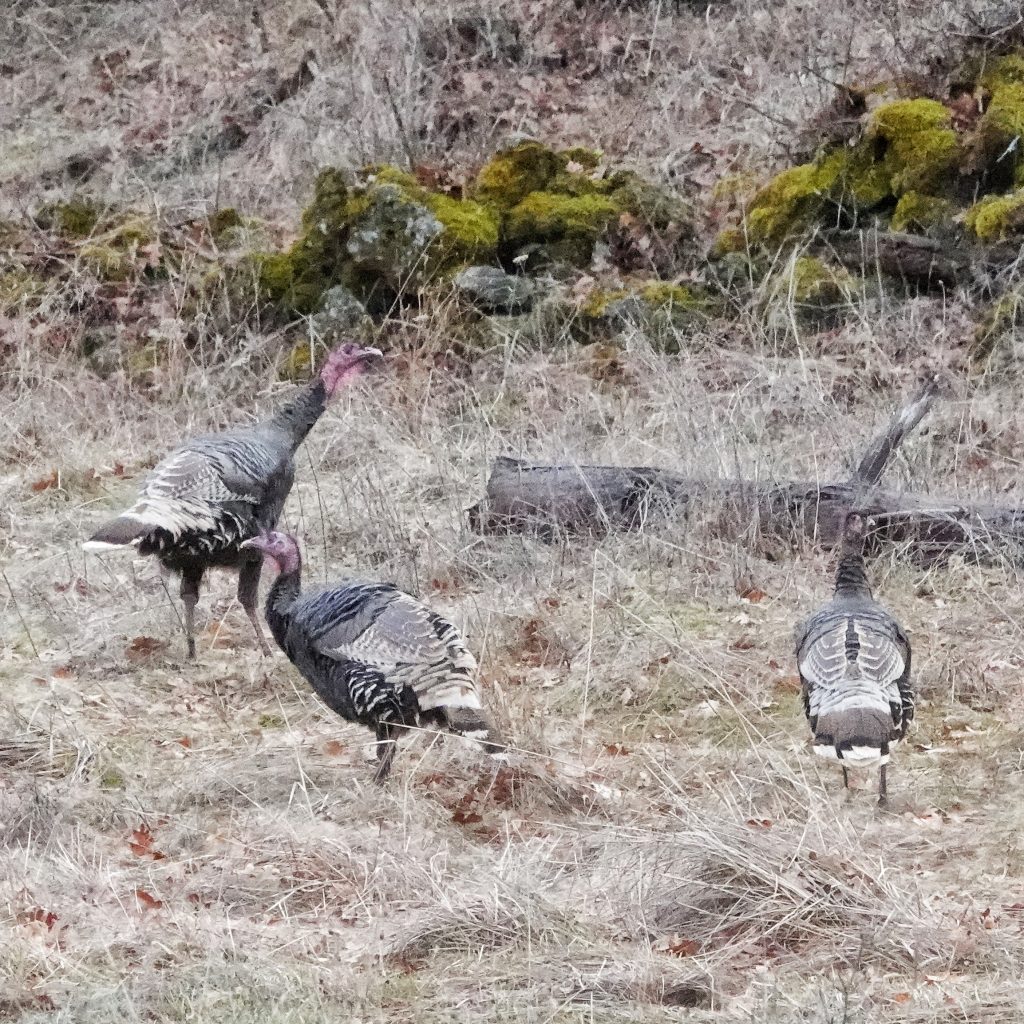
Description– Very large (adult males are 39-49” long and weigh up to 25 lbs, females are 39-37” long and weigh up to 12 lbs- they are the heaviest birds in the order Galliformes) birds with featherless heads, and brown, red, and bronze feathers; both males and females have spurs, wattles, caruncles, and snoods, but they are much smaller and less distinctive on the hen; male feathers are more iridescent, their head is more reddish, and they have a long patch of coarse feathers growing from the center of the chest, which is called a beard (though, for unknown reasons, some females also have beards).
Similar species– Nothing else in our region resembles adult wild turkeys.
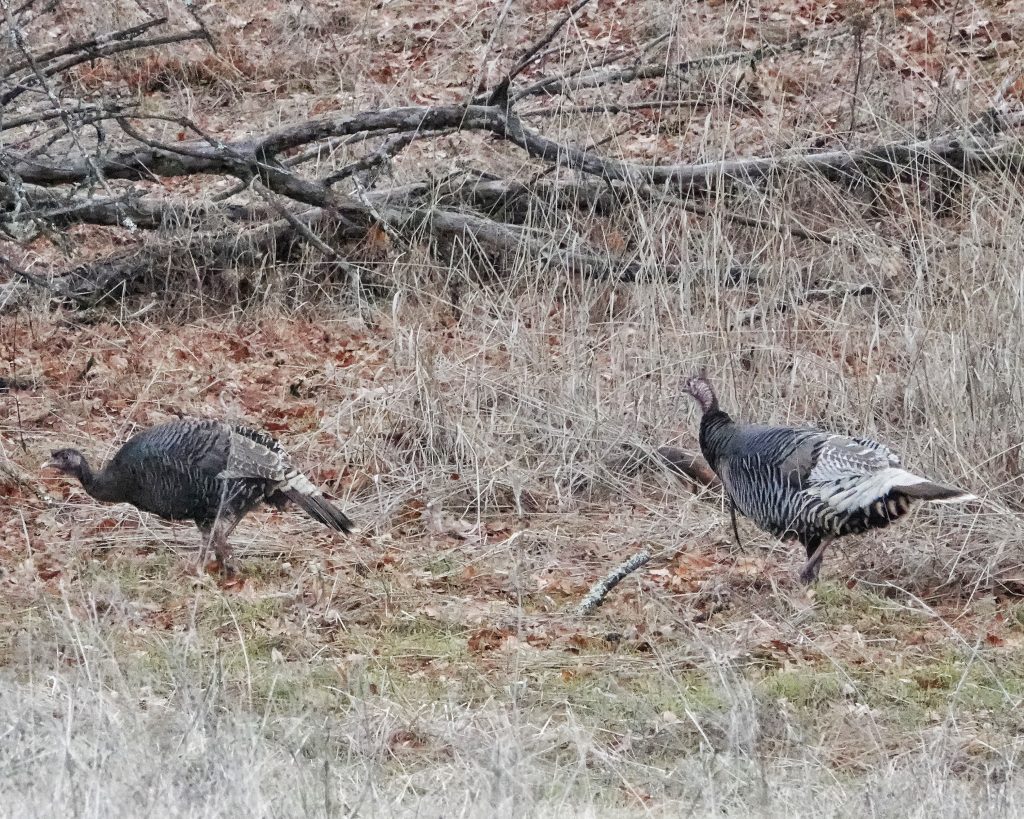
Habitat– Mixed hardwood and conifer forests and open pine forests, grasslands and prairies, canyonlands.
Range-Native range is eastern North America from southern Canada into Mexico, and west into Colorado and Arizona; presently restored to most of its historic range (and has expanded its range in some of those areas), and has been introduced into many parts of the western US; in the PNW they have been introduced to n and sw Idaho, nw Montana, sw, ne, and c Oregon and in the Willamette Valley, and in c, ne, and se Washington state, as well as in Lewis, Pierce, Thurston, Wahkiakum, and Cowlitz counties.
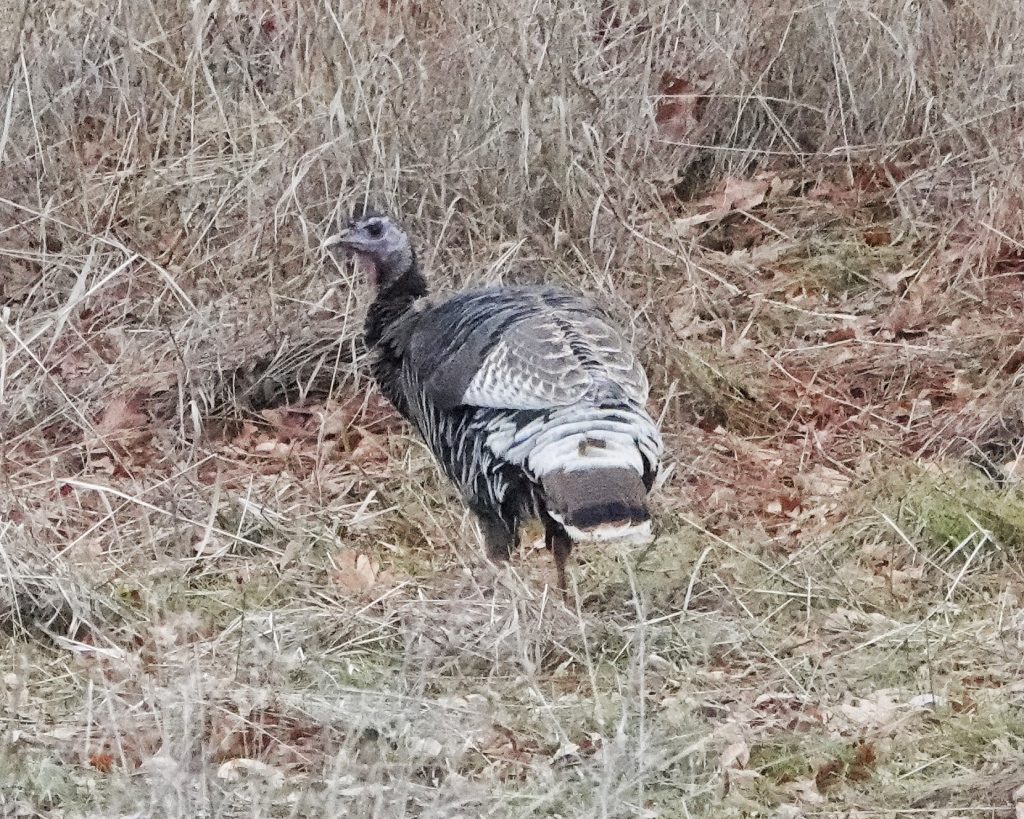
Eats– Omnivorous and varied, eating arthropods and other invertebrates, leaves and grass seeds and blades, berries, nuts, sedge and other seeds, acorns, conifer buds, ferns, clubmosses, bulbs, and small reptiles and amphibians
Eaten by– Any carnivores that can catch and subdue them, including raccoons, fox, coyotes, bobcats, cougars, golden eagles, and great horned owls; nest predators include rat snakes, bull snakes, marmots and other rodents, skunks, opossums, raccoons, and foxes.
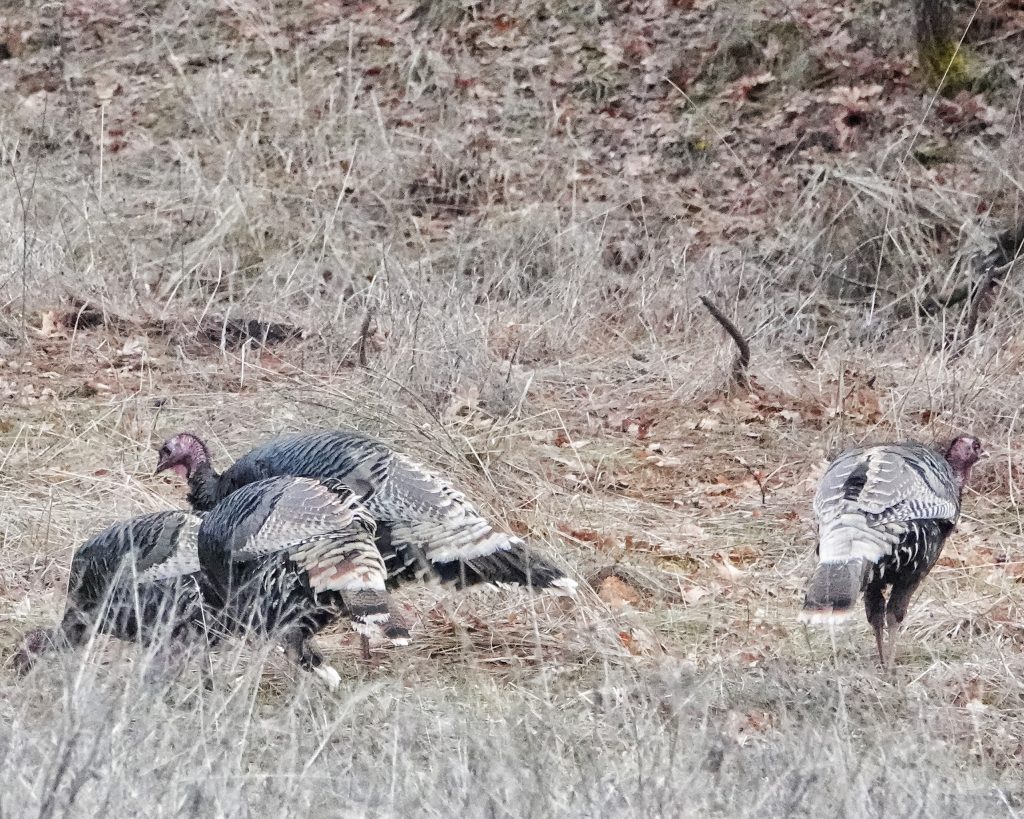
Life cycle– Breeding takes place in the spring; nests are shallow depressions on the ground lined with grass and leaves, often at the base of a tree or shrub; occasionally more than one hen will use a given nest; hens lay 4-18 (usually 10-15) eggs over the course of two weeks, and incubate them for 25-31 days; chicks are precocial, but the mother feeds them until they are effective at finding their own food, and broods them at night for several weeks; young can make short flights in 1-2 weeks, but take several months to reach full size; life span is usually 3-5 years in the wild.
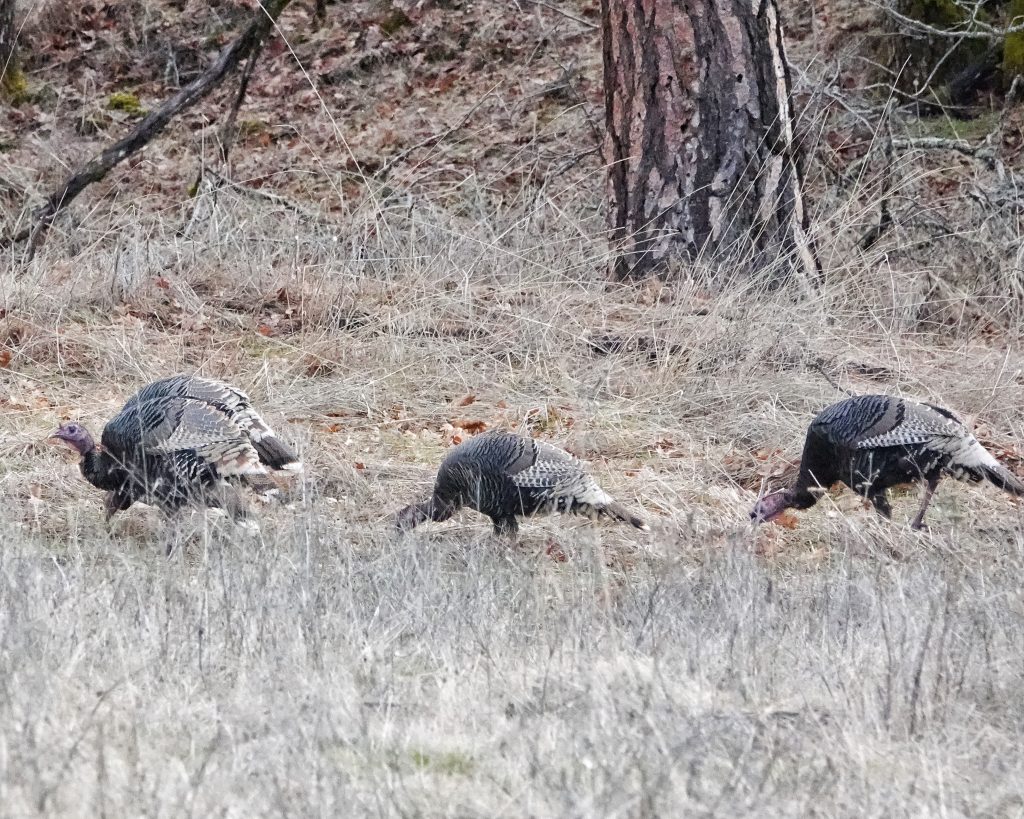
Adults active– Year around
Etymology of names– Meleagris is from the Ancient Greek words for ‘Guinea fowl’. The specific epithet gallopavo is from the Latin words for ‘chicken’ and ‘peacock’, referring to the chicken-like morphology, and the tom turkey’s habit of spreading its tail feathers in a display. The common name turkey comes from early settlers thinking that it resembled guineafowl that were either native to the nation of Turkey, or were imported by Turkish merchants.
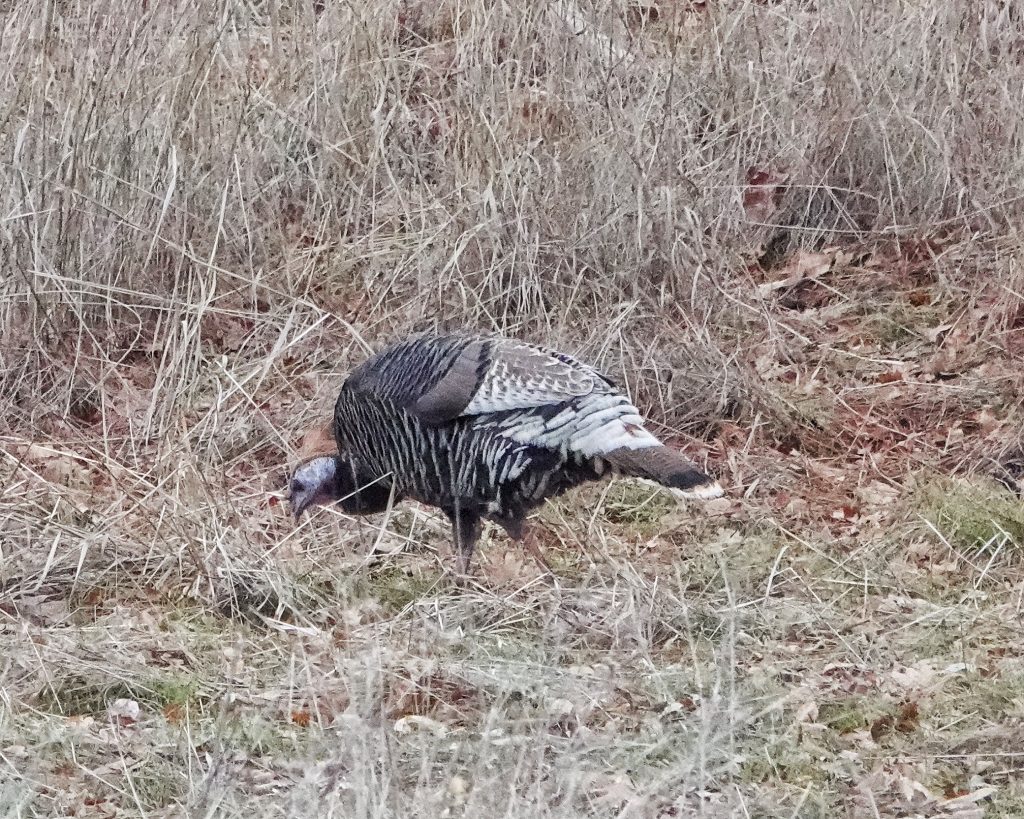
Wild Turkey Fact Sheet | Blog | Nature | PBS
https://www.allaboutbirds.org/guide/Wild_Turkey/lifehistory
Wild Turkey Overview, All About Birds, Cornell Lab of Ornithology
Wild Turkey | Audubon Field Guide
Wild Facts About Wild Turkeys | U.S. Fish & Wildlife Service
10 Fun Facts About the Wild Turkey | Audubon
https://www.mdwfp.com/media/4016/historywildturkeynorthamerica.pdf
https://wdfw.wa.gov/species-habitats/species/meleagris-gallopavo
https://myodfw.com/game-bird-hunting/species/wild-turkey
https://www.realtree.com/turkey-hunting/turkey-hunting-nation/2022/idaho-turkey-hunting
Snood – Turkey Anatomy – Parts of a Bird
https://en.wikipedia.org/wiki/Caruncle_(bird_anatomy)
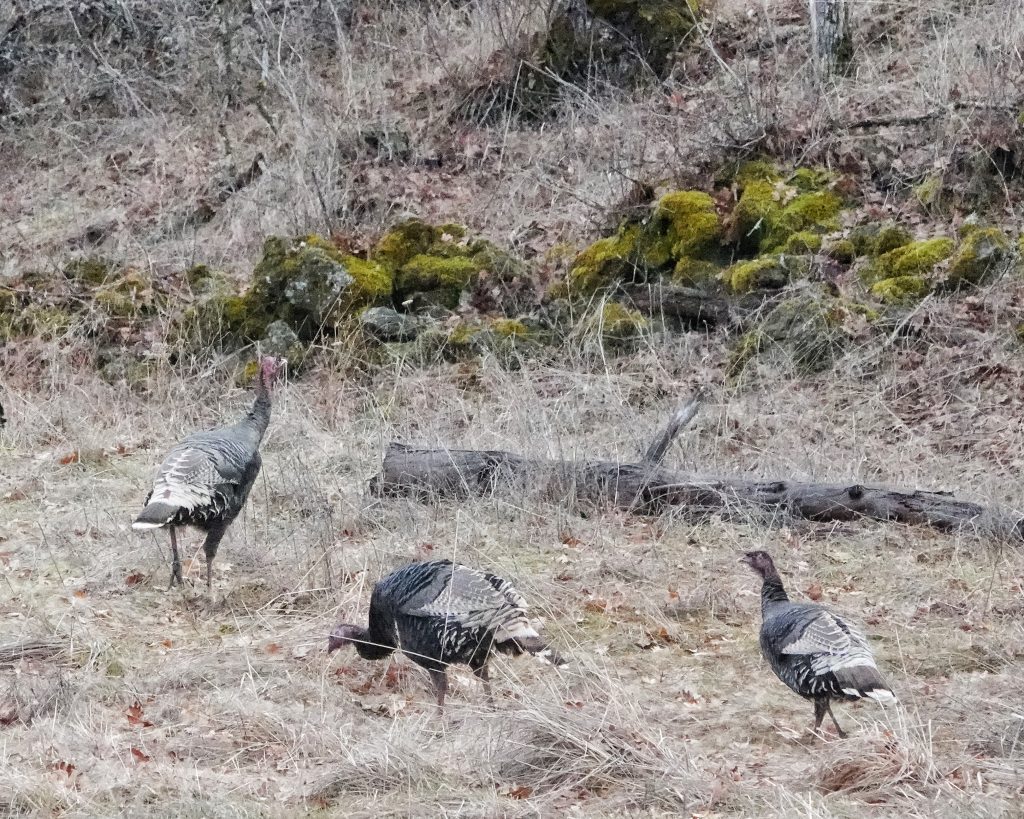
Over thirty years ago, while working for the Confederated Tribes of the Colville Reservation, I recall that in addition to the Merriam turkeys, the Wildlife guys had introduced Rio Grande in the more open SE corner of the Reservation. So, for the Rio Grande you might want to add that they were introduced to NE Washington. I don’t know if that introduction was a success, so maybe a call to their natural resources office can confirm my recollection and clarify if they still have those species on the rez.
Thanks for the information! I was also informed that there have been introductions of Rios by private parties in various locations.
I live in the gorge
It’s beautiful place!